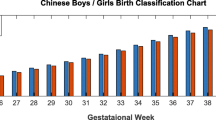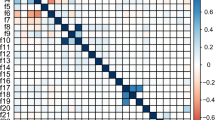Abstract
We propose a cluster-based feature selection (CFS) scheme to establish an efficient prognosis process for the identification of a Macrosomia fetus. Macrosomia fetus adheres numerous complications during and after the antepartum period and is among established reasons for neonate mortality. Almost all of the classifiers with the proposed CFS scheme elevated macrosomia prediction scores compare to previously published studies. The prediction scores are increased by \(+4\%\) and \(+12\%\) in terms of precision and Area under the curve which authenticates the applied scheme. Therefore, we suggest pediatricians use CFS scheme with Support Vector Machine (SVM) for develo** better prognosis process to develop the best macrosomia prediction framework.
Access this chapter
Tax calculation will be finalised at checkout
Purchases are for personal use only
Similar content being viewed by others
References
Battaglia, F.C., Lubchenco, L.O.: A practical classification of newborn infants by weight and gestational age. J. Pediatrics 71(2), 159–163 (1967)
Skou, J., Kesmodel, U., Henriksen, T.B., Secher, N.J.: An increasing proportion of infants weight more than 4000 grams at birth. Acta Obstetricia Et Gynecologica Scandinavica 80(10), 931–936 (2001)
Ross, J.A.: High birthweight and cancer: evidence and implications. Cancer Epidemiol. Prev. Biomarkers 15(1), 1–2 (2006). http://cebp.aacrjournals.org/content/15/1/1
Ahlgren, M., Wohlfahrt, J., Olsen, L.W., Srensen, T.I., Melbye, M.: Birth weight and risk of cancer. Cancer 110(2), 412–419 (2007). https://doi.org/10.1002/cncr.22773
Hediger, M.L., Overpeck, M.D., McGlynn, A., Kuczmarski, R.J., Maurer, K.R., Davis, W.W.: Growth and fatness at three to six years of age of children born small- or large-for-gestational age. Pediatrics 104(3), e33–e33 (1999). http://pediatrics.aappublications.org/content/104/3/e33
Dietz, W.H.: Overweight in childhood and adolescence. New Engl. J. Med. 350(9), 855–857 (2004). https://doi.org/10.1056/NEJMp048008. pMID: 14985480
Li, J., Wang, F.: Semi-supervised learning via mean field methods. Neurocomputing 177, 385–393 (2016)
Zahra, S., Ghazanfar, M.A., Khalid, A., Azam, M.A., Naeem, U., Prugel-Bennett, A.: Novel centroid selection approaches for kmeans-clustering based recommender systems. Inf. Sci. 320, 156–189 (2015). http://www.sciencedirect.com/science/article/pii/S0020025515002352
Guo, L., Yang, J.J., Peng, L., Li, J., Liang, Q.: A computer-aided healthcare system for cataract classification and grading based on fundus image analysis. Comput. Ind. 69, 72–80 (2015). Special Issue: Information Technologies for Enhanced Healthcare
Luangkwan, S., Vetchapanpasat, S., Panditpanitcha, P., Yimsabai, R., Subhaluksuksakorn, P., Loyd, R.A., Uengarporn, N.: Risk factors of small for gestational age and large for gestational age at Buriram hospital. J. Med. Assoc. Thai. 98(4), S71–S78 (2015)
Moore, G.S., Kneitel, A.W., Walker, C.K., Gilbert, W.M., **ng, G.: Autism risk in small-and large-for-gestational-age infants. Am. J. Obstet. Gynecol. 206(4), 314.e1–314.e9 (2012)
Chen, Q., Wei, J., Tong, M., Yu, L., Lee, A.C., Gao, Y.F., Zhao, M.: Associations between body mass index and maternal weight gain on the delivery of LGA infants in chinese women with gestational diabetes mellitus. J. Diab. Complications 29(8), 1037–1041 (2015)
Akhtar, F., Li, J., Azeem, M., Chen, S., Pan, H., Wang, Q., Yang, J.J.: Effective large for gestational age prediction using machine learning techniques with monitoring biochemical indicators. J. Supercomput. (2019). https://doi.org/10.1007/s11227-018-02738-w
Akhtar, F., Li, J., Guan, Y., Imran, A., Azeem, M.: Monitoring bio-chemical indicators using machine learning techniques for an effective large for gestational age prediction model with reduced computational overhead. In: The 7th International Conference on Frontier Computing (FC 2018) - Theory, Technologies and Applications (2018)
Zhang, S., Wang, Q., Shen, H.: Design implementation and significance of Chinese free pre-pregnancy eugenics checks project. Natl. Med. J. China 95(3), 162–165 (2015)
Zhu, L., Zhang, R., Zhang, S., Shi, W., Yan, W., Wang, X., Lyu, Q., Liu, L., Zhou, Q., Qiu, Q.: Chinese neonatal birth weight curve for different gestational age. Zhonghua Er Ke Za Zhi 53(2), 97–103 (2015)
Li, J., Lu, L., Sun, J., Mo, H., Yang, J.J., Shi, C., Liu, H., Wang, Q., Hui, P.: Comparison of different machine learning approaches to predict small for gestational age infants. IEEE Trans. Big Data PP(99), 1–14 (2016)
Li, J., Liu, C., Liu, B., Mao, R., Wang, Y., Chen, S., Yang, J.J., Pan, H., Wang, Q.: Diversity-aware retrieval of medical records. Comput. Ind. 69, 81–91 (2015)
Akhtar, F., Li, J., Pei, Y., Azeem, M.: A semi-supervised technique for LGA prognosis. In: Proceedings of The International Workshop on Future Technology FUTECH 2019, pp. 36–37 (2018)
Acknowledgement
This study is supported by the National Key R&D Program of China with project no. 2017YFB1400803.
Author information
Authors and Affiliations
Corresponding author
Editor information
Editors and Affiliations
Rights and permissions
Copyright information
© 2020 Springer Nature Singapore Pte Ltd.
About this paper
Cite this paper
Akhtar, F., Li, J., Pei, Y., Siraj, S., Shaukat, Z. (2020). Macrosomia Fetus Prediction with Cluster-Based Feature Selection Scheme. In: Hung, J., Yen, N., Chang, JW. (eds) Frontier Computing. FC 2019. Lecture Notes in Electrical Engineering, vol 551. Springer, Singapore. https://doi.org/10.1007/978-981-15-3250-4_7
Download citation
DOI: https://doi.org/10.1007/978-981-15-3250-4_7
Published:
Publisher Name: Springer, Singapore
Print ISBN: 978-981-15-3249-8
Online ISBN: 978-981-15-3250-4
eBook Packages: Intelligent Technologies and RoboticsIntelligent Technologies and Robotics (R0)




